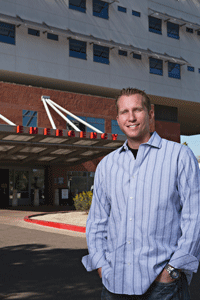 Officer Chris Bennett had seen St. Joseph’s trauma team at work numerous times in his years as a Phoenix police officer. Part of his job includes accompanying the victims of shootings, car accidents and assaults to the Level 1 trauma center for treatment.
Officer Chris Bennett had seen St. Joseph’s trauma team at work numerous times in his years as a Phoenix police officer. Part of his job includes accompanying the victims of shootings, car accidents and assaults to the Level 1 trauma center for treatment.
But on January 6, 2013, he became the patient. That evening, he had pulled over a suspicious bicyclist, who opened fire, shooting Officer Bennett six times. Three bullets to the torso were stopped by the officer’s body armor, but one shattered his jaw, one lodged in his back, and the other ripped through his forearm.
“Mental preparation is a big part of the job,” Officer Bennett says. “Literally daily when I went into work, I prepared myself for this process. In the academy they tell you to ‘what if...’ everything to death.”
He stayed calm, stayed conscious and called on his radio for help. But after the ambulance arrived, his life was in others’ hands.
“When I rolled into the trauma room and saw the doctors and nurses, I knew everything would be OK,” he says. “I knew at that point anything I had to treat, they could handle.”
Serving the community
As one of five Level 1 trauma centers in Phoenix, St. Joseph’s sees its share of officers injured on the job. Centers are designated Level 1 by the American College of Surgeons as being able to handle any and all kinds of traumatic injuries.
Though St. Joseph’s staff cares for all patients with the same high professional standards, knowing the patient is a police officer adds another dimension of urgency.
“It is different,” says Dana Stout, an RN who has worked in the trauma center for 10 years. “They’re out there protecting you and me and keeping intoxicated people off the street and keeping us safe.”
One wall of the center is decorated with photographs of Phoenix officers killed in the line of duty, along with rubbings of engravings of their names from the National Law Enforcement Officers Memorial in Washington, DC.
“I go past that wall every day,” Stout says. “Whenever we get a call that an officer’s been injured, I just say to myself, ‘I don’t want to put his photo on the wall.’”
As a trauma clinician, Stout follows the patient from before their arrival throughout their entire time in the trauma center. She was working the night of Officer Bennett’s shooting. Among the small army of doctors, nurses, respiratory therapists, X-ray technicians, phlebotomists, chaplain and others attending to his care, she stood out.